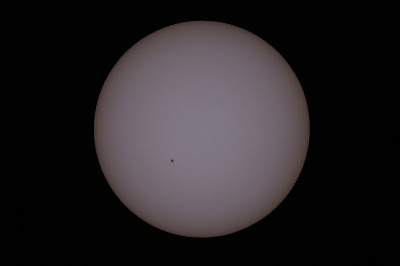These images show the sunspot groups that were visible on the face of the Sun during the partial phase of the 2017 August 21 total eclipse.
The first image was taken on August 20, 2017, the day before the total solar eclipse with my Canon 70D attached to my 8 inch EdgeHD telescope. The two sunspot groups include the group near center and another group coming around the east side of the Sun. The exposure was 1/1000 seconds at ISO 200, f/10.
This image was taken after the end of the total solar eclipse on August 21, 2017. It shows the two sunspot groups visible during the eclipse. The image was taken with my Canon 70D attached to my 8 inch EdgeHD telescope with an exposure of 1/1000 seconds at ISO 200, f/10.
This is a closeup of the central sunspot group cropped from the above image with a little sharpening and brightness stretching to enhance the appearance a little.
This is a closeup of the sunspot group on the eastern limb of the Sun, just a couple days from making its initial appearance on the eastern limb. I cropped this from the above image and applied a little sharpening and brightness stretching to enhance the appearance a little.
Click on a photo to see a larger version of the image.
Tuesday, August 29, 2017
August 21, 2017 total eclipse - the diamond ring
This image was taken at the end of the total phase of the 2017 August 21 total solar eclipse just as the Sun reappeared on the west side of the Moon. This image was taken with my 8 inch EdgeHD Celestron telescope with my Canon 6D attached via a 0.7x focal reducer. The exposure was 1/500 seconds at ISO 200.
Total Eclipse, 2017 August 21 - West side prominences.
This image was taken just before the photosphere reappeared on the west side of the Sun at the end of the total phase of the 2017 August 21 total eclipse. This image was taken with my Canon 6D attached to my 8 inch EdgeHD telescope with a 0.7x focal reducer with an exposure of 1/500 seconds at ISO 200.
August 21, 2017 total eclipse
During the total solar eclipse on 2017 August 21, I shot a sequence of 5 exposures, each 2 stops from its neighbor, in order to get reasonable exposures on prominences on the bright end the solar corona on the fainter end. In this case, I used my Canon 6D with a 0.7x focal reducer on my f/10 Celestron EdgeHD 8 inch telescope with exposures of 1/500 sec, 1/125 sec, 1/30 sec, 1/8 sec, and 1/2 seconds going down the images below. These images were taken early in the eclipse so that the Sun's photosphere is just covered by the Moon on the east (left) side while the west (right) side is well covered by the Moon.
Saturday, August 05, 2017
Eclipse photography practice.
The August 21st Solar Eclipse is just 16 days away so it's time to practice some setup and photography of the Sun. In this case, I used my Canon 6D with its full frame sensor on my Celestron EdgeHD 8 inch telescope and a white light solar filter. For the eclipse, I'll use a 0.7x focal reducer to get a bigger field of view for the phenomena around the Sun and Moon.
This is the full image with some sharpening and contrast stretching. The C8 is an f/10 telescope with 2032mm focal length. You an see some sunspots a little left and below the center of the Sun. You can also see lots of granulation on the Sun in general and I was hoping to see a little more activity. The eclipse is on August 21st, 16 days after this image, so given that the synodic rotation period of the Sun is about 27 days, this sunspot group will be on the other side of the Sun, at least a few days from coming around the edge. This exposure was 1/1000 seconds at ISO 200 using my Canon 6D.
This is a closeup of the image above to get a better look at the small sunspot group. You can see at least three sunspots in the group and maybe a couple more small ones if you use your imagination a little. The Sun was getting a bit low in the sky, so there is some atmospheric color dispersion - the top of the spot looks a little red while the bottom looks a little blue.
Subscribe to:
Comments (Atom)












